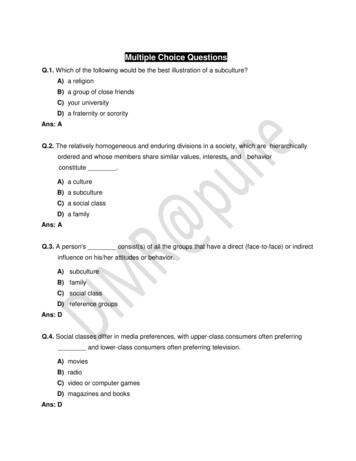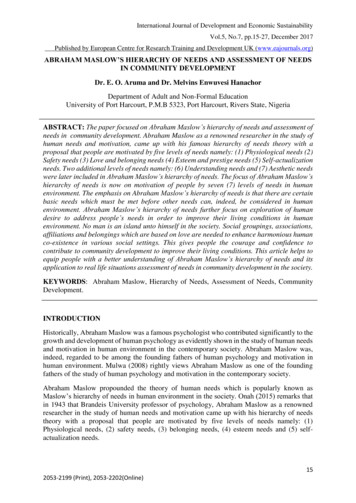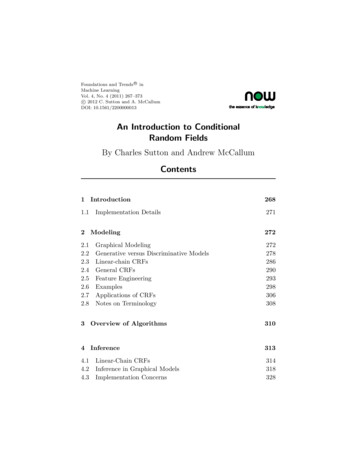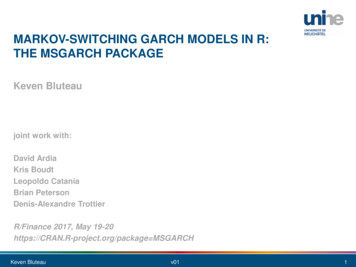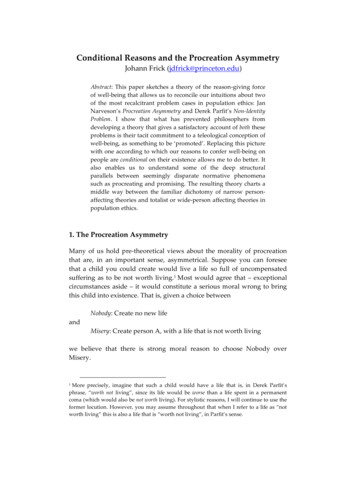
Transcription
Conditional Reasons and the Procreation AsymmetryJohann Frick (jdfrick@princeton.edu)Abstract: This paper sketches a theory of the reason-giving forceof well-being that allows us to reconcile our intuitions about twoof the most recalcitrant problem cases in population ethics: JanNarveson’s Procreation Asymmetry and Derek Parfit’s Non-IdentityProblem. I show that what has prevented philosophers fromdeveloping a theory that gives a satisfactory account of both theseproblems is their tacit commitment to a teleological conception ofwell-being, as something to be ‘promoted’. Replacing this picturewith one according to which our reasons to confer well-being onpeople are conditional on their existence allows me to do better. Italso enables us to understand some of the deep structuralparallels between seemingly disparate normative phenomenasuch as procreating and promising. The resulting theory charts amiddle way between the familiar dichotomy of narrow personaffecting theories and totalist or wide-person affecting theories inpopulation ethics.1. The Procreation AsymmetryMany of us hold pre-theoretical views about the morality of procreationthat are, in an important sense, asymmetrical. Suppose you can foreseethat a child you could create would live a life so full of uncompensatedsuffering as to be not worth living.1 Most would agree that – exceptionalcircumstances aside – it would constitute a serious moral wrong to bringthis child into existence. That is, given a choice betweenNobody: Create no new lifeandMisery: Create person A, with a life that is not worth livingwe believe that there is strong moral reason to choose Nobody overMisery.More precisely, imagine that such a child would have a life that is, in Derek Parfit’sphrase, “worth not living”, since its life would be worse than a life spent in a permanentcoma (which would also be not worth living). For stylistic reasons, I will continue to use theformer locution. However, you may assume throughout that when I refer to a life as “notworth living” this is also a life that is “worth not living”, in Parfit’s sense.1
Next, imagine that you could create a child with a life that would bewell worth living; perhaps you could even create a child with a veryhappy life. Many have the intuition that it is morally indifferent whetheryou decide to create such a child or not. All else equal, it seemspermissible for you to have the child if you wish; but we don’t believe thatyou act contrary to strong moral reasons, let alone a moral obligation, ifyou decide not to. That is, given a choice betweenNobody: Create no new lifeGood: Create person B, with a moderately happy lifeor a choice betweenNobody: Create no new lifeGreat: Create person C, with a very happy lifeor indeed a choice between all three options, many believe there is nomoral reason to choose Great, or Good, over Nobody. Taken together,these intuitions make up what philosophers in the field of populationethics call the Procreation Asymmetry (or Asymmetry for short):2Procreation Asymmetry:(1) If a future person would foreseeably have a life that isnot worth living, this in itself gives us a strong moral reasonto refrain from bringing this person into existence.By contrast, (2) there is no moral reason to create a personwhose life would foreseeably be worth living, just becauseher life would be worth living.3My aim in this paper is to provide a defense of the ProcreationAsymmetry.The Asymmetry was first discussed by Jan Narveson in “Utilitarianism and NewGenerations”, Mind 76 (1967), pp. 62–72. The label is due to Jeff McMahan, “Problems ofPopulation Theory”, Ethics, 92 (1981), pp. 96-127.3 In this essay I do not take a stand on what, exactly, makes a life worth living or not worthliving for a person. That is, I shall remain agnostic with regard to the correct theory of wellbeing (which I understand as that which makes a person’s life worth living for that person).The Asymmetry, I argue, is true whichever theory of well-being we have most reason toendorse. In keeping with established practice in the literature on the Asymmetry, Isometimes employ the phrases “a happy life” and “a miserable life” as synonyms for “a lifeworth living” and “a life not worth living”. “Happy” and “miserable” should here beunderstood in a sense that is agnostic with regard to the true theory of well-being.22
2. Three Adequacy ConditionsWith few exceptions, those who reject the Procreation Asymmetry acceptthe first conjunct but deny the second. Instead, they affirm that we do havesignificant moral reasons to create new people whose lives would beworth living because they would be worth living. I shall refer to theseopponents of the Procreation Asymmetry as holding a symmetry view.Proponents of symmetry views can be grouped into two overlappingcamps: First, there are totalist act utilitarians, who believe that we alwayshave decisive moral reason to do what makes the world go best, namely toproduce the greatest possible net aggregate of well-being over ill-being.Totalists reject the Asymmetry, since creating a new happy person, justlike making an existing person happy, is a way of adding well-being to theworld. Second, the Asymmetry is rejected by all those philosophers whothink that we have moral reason to benefit people by bringing them intoexistence.The aim of this paper is not to present a knock-down argument againstsuch symmetry views. Given the very fundamental nature of thisdisagreement, such an argument would be hard to come by. Moreimportantly, there is a sense in which such an argument is not needed. TheAsymmetry strikes many people – even some of those who have opposedit in print – as intuitively highly plausible. For instance, John Broome, afteralmost fifteen years of arguing against the intuition, confesses to still beinggripped by it:We [intuitively] care about the well-being of people whoexist; we want their well-being to be increased. If it isincreased, an effect will be that there will be more wellbeing in the world. But we do not want to increase theamount of well-being in the world for its own sake. Adifferent way of achieving that result would be to havemore people in the world, but most of us are not in favor ofthat. We are not against it either; we are neutral about thenumber of people.4John Broome, Climate Matters: Ethics for a Warming World (New York: Norton, 2012), p.171.43
Furthermore, common-sense ethical thought rejects many of the stronglyrevisionary implications that symmetry views would appear to have.Again I quote from Broome:When people’s lives are saved, by making roads safer or inother ways, the well-being of the people who are saved isgenerally small in comparison to the well-being of all thenew people, their descendants, who come into existence asa result. This is perfectly predictable. If all the descendants’well-being had to be counted too, that would enormouslyalter the value we attach to saving people’s lives. Butactually, in judging the value of safety on the roads, weroutinely ignore all this well-being.5Finally, upholding the Asymmetry intuition also has important theoreticalpayoffs within the field of population ethics, since rejecting (2) invites aversion of Parfit’s Repugnant Conclusion. If we have pro tanto moral reasonto create any life that is worth living, this opens up the possibility thatcreating a world in which a very large number of people have lives thatare barely worth living is morally preferable to one in which every memberof a smaller population enjoys an excellent life.What has stood in the way of more widespread acceptance of theProcreation Asymmetry amongst population ethicists is that, to date, allattempts at fleshing out and defending this intuition have encounteredserious difficulties. In particular, I claim, there are three minimal adequacyconditions which no existing account of the Procreation Asymmetry has sofar managed to satisfy.First, it has proven surprisingly difficult to give an account of theProcreation Asymmetry that does not preclude us from giving theintuitively correct verdict about another famous problem case inpopulation ethics, Derek Parfit’s Non-Identity Problem6. Consider:Non-Identity Case:You are contemplating whether to have a child. You face acostless choice between three options:Nobody: Create no new lifeGood: Create person B, with a moderately happy life“Should We Value Population?”, The Journal of Political Philosophy, Vol. 13, No. 4 (2005):399-413, p. 402.6 Derek Parfit, Reasons and Persons (Oxford: Oxford University Press, 1984), Ch. 16.54
Great: Create person C, with a very happy life.Assume that the reason why person B would have a life that is foreseeablyless happy than that of person C is that B would be born with a life that,while still well worth living, is affected by a serious congenital ailment.The judgment that almost everyone has about this case is this:Non-Identity Intuition: You have a strong moral reason notto choose Good over Great.7Indeed, your reason not to choose Good over Great in this case seemscomparable in strength to your reason not to choose Good over Better inthe following Same-Person Case8:Same-Person Case:You face a choice between three options:Nobody: Create no new lifeGood: Create person B, with a moderately happy lifeBetter: Create person B, with a very happy life.The problem, as I show in the next section, is that most existing attemptsto defend the Procreation Asymmetry commit us to rejecting the NonIdentity Intuition. This seems an unacceptable price to pay. Thus, the firstadequacy condition on a defense of the Procreation Asymmetry is that itallows us to uphold the Non-Identity Intuition.7For my own, more detailed take on this ‘genetic’ version of Parfit’s Non-Identity Problem,see my “Zukünftige Personen und Schuld ohne Opfer” (“Future Persons and VictimlessWrongdoing”) in Markus Rüther and Sebastian Muders (eds.) Worauf es ankommt: DerekParfits praktische Philosophie in der Diskussion (Hamburg: Felix Meiner Verlag, forthcoming).8 Parfit endorses a stronger claim, the No Difference View, according to which there is nomorally relevant difference between a same-person choice, in which choosing Good is worsefor person B than another available option, and a different-person choice, like Non-IdentityCase, in which choosing Good is not worse for anybody, provided the two actions haveequivalent overall effects. (Reasons and Persons, pp. 366-369). We need not, however, acceptthe No Difference View. Thus, it might be argued that one difference between the two casesis that while in Same Person Case, choosing Good wrongs a person, choosing Good in NonIdentity Case wrongs no-one, and that this difference affects the comparative strength ofour reasons against choosing option Good in either case. For a development of this point,see my “Zukünftige Personen und Schuld ohne Opfer”.5
In addition, I believe that a successful account of the ProcreationAsymmetry must offer a non-question begging response to two basicchallenges.Consider first what I term the Objection from Benefit: We all recognizethat we have pro tanto moral reasons to benefit existing people by doingwhat is good for them – for instance saving their lives, which allows themto live longer. Given this, shouldn’t we recognize a corresponding moralreason to benefit future people, by bringing them into existence with a lifeworth living?Note that proponents of this Objection from Benefit need not becommitted to the claim that it is better (or worse) for a person to be broughtinto existence. This claim has struck many philosophers as incoherent,since, they contend, it implies that it would have been worse for that personnever to have existed. But this, it is argued, cannot be the case. If theindividual in question never exists, there is no person for whom nonexistence is worse, and consequently no-one for whom existence wouldhave been better. The comparandum lacks a subject. 9 (Recall the oldYiddish joke: “Life is so terrible, it would be better never to have beenborn.” Response: “Who is so lucky? Not one in ten thousand!” The jokeworks, because people who never exist can be neither the subjects offortune or misfortune).There is, however, a way of putting the Objection from Benefit thatdoes not encounter such conceptual difficulties. As Jeff McMahan pointsout, it is both coherent and plausible that being caused to exist with a lifeworth living can be good for a person in a non-comparative sense, namelyinsofar as “the intrinsically good elements of the person’s life more thancompensate for the intrinsically bad elements.”10 This can be true despitethe fact that the outcome in which she does not exist would not have beenbad, or worse, for her. Mutatis mutandis, it can be non-comparatively badfor a person to be brought into existence with a life that is overall notworth living, despite the fact that never existing would not have beengood, or better, for her. Because bringing a person into existence can begood or bad for her in this non-comparative sense, it is also plausible tospeak of acts of procreation as “benefiting” and “harming” those whomthey create. (McMahan calls these “existential” benefits and harms, inFor versions of this argument, see Krister Bykvist, “The Benefits of Coming intoExistence”, Philosophical Studies (2007), pp. 95-115 and Jeff McMahan, “Causing People toExist and Saving People’s Lives”, The Journal of Ethics (2013), pp. 5-35. For a dissentingview, see Nils Holtug, “On the Value of Coming into Existence”, Journal of Ethics (2001), pp.361-384.10 “Causing People to Exist and Saving People’s Lives”, p. 6.96
contrast with “ordinary” benefits and harms, “which are bestowed orinflicted on existing people, or on future individuals whose existence isindependent of the act that causes or constitutes the benefit or harm.”11).The question raised by the Objection from Benefit, then, is this: If whatis good for existing people (ordinary benefits) makes a moral claim on us,why not also what is good for possible future persons (existentialbenefits)?Fully grasping the Objection from Benefit will immediately block onemistaken way of thinking about the Procreation Asymmetry, namely toview it as just an instance of a more general moral asymmetry between thestrength of our reasons not to harm and the strength of our reasons tobenefit other people. Those who accept the Asymmetry believe, toparaphrase Jan Narveson’s famous dictum, that while there are oftenweighty moral reasons to make (existing) people happy, there is nocorresponding moral reason to make happy people. By contrast, note thatthere is no such intuitive asymmetry when speaking of miserable lives: Ourmoral reasons against creating new lives that are miserable seem just asweighty as our reasons against making existing lives miserable.Thus, as Figure 1 illustrates, even if there is a general moral asymmetrybetween the strength of my reason not to harm and the strength of myreason to benefit other people, this couldn’t explain why, while I oftenhave weighty moral reasons to provide ordinary benefits to people, I haveno moral reason to provide existential benefits to people by creating them.Figure 1: The putative general asymmetry between harming and benefitingcan explain why, all else equal, R1 is stronger than R2 and R3 is stronger thanR4. But it cannot explain why R2 is stronger than R4.11Ibid., p. 7.7
Second, there is what I call the Objection from Symmetry: We accept thatif causing a person to exist would foreseeably be bad for that person,because her life would be not worth living, this gives us moral reasonagainst bringing her into being. By symmetry of reasoning, why does thefact that causing a person to exist would foreseeably be good for thatperson, because her life would be worth living, not give us moral reasonfor bringing her into being?I have explained my objective in this paper and stated three minimaladequacy conditions on successfully accomplishing it. Let me now brieflylay out how I shall proceed from here.The argument of my paper will unfold in three parts. In Section 3, Isurvey a number of previous attempts to account for the ProcreationAsymmetry, and show that they are all unsatisfactory, since they wouldcommit us to rejecting the Non-Identity Intuition. I then argue that thecommon element that has bedeviled these previous attempts is a tacitcommitment to a teleological conception of well-being, as something to be‘promoted’.In Sections 4 and 5, I set about clearing away this problematicassumption and replacing it with a more plausible account of the reasongiving force of well-being. According to the view I advocate, our moralreasons to confer well-being on people are what I call “bearer-dependent”reasons, and as such are conditional on the fact that the person beingbenefited exists. This allows me to offer an account of the ProcreationAsymmetry that strikes me as both theoretically neat and inherentlyplausible, and allows me to meet the Objections from Benefit andSymmetry.Finally, in Sections 6-9, I develop a unified account of the morality ofprocreation, which accommodates all the intuitive data underconsideration, namely both conjuncts of the Procreation Asymmetry, aswell as our moral judgments about Same-Person Case and Non-IdentityCase.3. The Procreation Asymmetry Versus the Non-Identity IntuitionProponents of the Procreation Asymmetry, we have seen, embrace twoclaims:(i) You have a strong moral reason to choose Nobody overMisery.(ii) You have no moral reason to choose Great, or Good,over Nobody.8
As I shall now show, one of the key stumbling blocks for a plausibledefense of the Asymmetry is to explain how (i) and (ii) can both be true,without being committed to denying the Non-Identity Intuition, accordingto which(iii) You have a strong moral reason not to choose Goodover Great.Now, one moral view which has no problems explaining the truth of (iii)is, of course, totalist utilitarianism. According to totalism, we havedecisive moral reason to do what makes the world go best, namely toproduce the greatest possible net aggregate of well-being over ill-being. Inthe Non-Identity Case, choosing Great adds more to the total sum ofwellbeing in the world than either Good or Nobody. So this is the optionthat, all else equal, we ought to pick, according to totalism. Hence, there isstrong moral reason not to choose Good over Great, as (iii) affirms.But the very feature which allows totalist utilitarians to provide aneasy account of the Non-Identity Intuition also forces them to reject thesecond conjunct of the Procreation Asymmetry. After all, creating a newperson with a life worth living will also add to the total amount ofwellbeing in the world. Hence, we have moral reason to do this. Thus,totalists can give the right answer to the Non-Identity Problem, but only atthe price of giving up proposition (ii).As we shall now see, most existing attempts to explain the ProcreationAsymmetry have encountered the reverse problem. Though the details oftheir proposals differ, most authors who have tried to defend theAsymmetry intuition have pursued a common strategy: Totalism holdsthat the potential well-being of all possible people is reason-giving. Bycontrast, these alternative views divide up possible people according totheir temporal location or their modal status, and assign different reasongiving force to the well-being of members in these various groups. 12Presentists draw a distinction between presently existing and presentlynon-existing people, and claim that only the well-being of presentlyexisting people provides us with any moral reasons; necessitariansdistinguish between people (present or future) who exist or will exist no12The following definitions are derived from Gustaf Arrhenius, Population Ethics: TheChallenge of Future Generations (ms.).9
matter how we decide to act, and people whose existence is contingent onour decisions; actualists separate people who exist or who are going toexist in the actual world, on the one hand, from people who don’t, andwon’t exist, on the other. (The Venn Diagram in Figure 2 illustrates theseways of dividing up the space of possible people13). In each instance, wewill see how the very feature that allows each of these accounts to captureone or both conjuncts of the Procreation Asymmetry commits it torejecting the Non-Identity Intuition.Figure 2Consider first the ‘generocentric’ view of David Heyd. This view( ) takes the present generation, viz. that making thedemographic choice, as the only relevant group to whichmoral considerations are applicable. ( ) The generocentricapproach grants a moral standing only to those who‘generate’ population growth, excluding such a standingfrom those who are ‘generated’, despite the fact that oncethey are ‘generated’ beings of this type are the same as their‘generators’ and accordingly enjoy a moral status. In otherwords, decisions to enlarge the moral community are takenThis diagram is adapted from Arrhenius, Population Ethics: The Challenge of FutureGenerations (ms).1310
only ‘from within’ and in the light of the rights, welfare,and interests of the original community.14Heyd’s view in this passage is a form of presentism, since it draws a moraldistinction between presently existing people and possible people who donot presently exist. 15 According to presentism, only the well-being ofpresently existing people gives us moral reasons of any kind. While thisview captures the second conjunct of the Asymmetry intuition – that wehave no reason to bring a possible person into existence just because herlife would be worth living for her – it runs counter to the first. Accordingto presentism, there is no welfare-related reason not to create a newperson whose life would be miserable, since moral considerationsstemming from people’s welfare apply only to those who presently exist.For the same reason, we have no moral reason not to choose Good overGreat in the Non-Identity Problem. Presentism is not a plausible view.Consider next a proposal mooted by Derek Parfit in Reasons andPersons as his best attempt to account for the Procreation Asymmetry.(Parfit himself rejects this proposal, for the reasons I elaborate below.16).According to the proposal,[I]t is wrong, if other things are equal, to do what would beeither bad for, or worse for, the people who ever live. It istherefore wrong to have the Wretched Child. Since his lifeis worse than nothing, having this child is bad for him. Butit is in no way wrong to fail to have the Happy Child,whose life would be well worth living. True, if the couplehad this child, this would be good for him. But if they donot have this child, this would not be bad for him.17Parfit’s proposal is a form of moral actualism. The only persons withregard to whom we have well-being-related reasons of any kind are actualpeople, i.e. the people who ever live, given our action. Other things beingequal, it is wrong to do what is bad for, or worse for, these people. ByDavid Heyd, “Procreation and Value: Can Ethics Deal With Futurity Problems?”,Philosophia 18 (1988): 151-170, pp. 158-9.15 There are other passages in which Heyd seems to endorse not presentism butnecessitarianism. The problems with necessitarianism are discussed below.16 Parfit’s proposal echoes a similar argument of Jan Narveson’s, who, unlike Parfit, doesappear to embrace moral actualism. See Jan Narveson, “Moral Problems of Population”,The Monist (1973), p. 73.17 Parfit (1984), p. 150.1411
contrast, it is in no way wrong to fail to create a life that would have beenworth living, since there are no moral reasons related to the well-being ofpeople who, given our choice of action, will never live. Moral actualismthus entails what Parfit calls the narrow person-affecting principle, accordingto which something is bad (or an action is wrong) only if it is bad for, orworse for, someone who ever lives.While it captures both conjuncts of the Procreation Asymmetry, theactualist proposal is subject to three serious objections, which give usreason to reject it.First, it seems extremely plausible to embrace what Krister ByvkistcallsNormative Invariance: An action’s normative status –whether it is right or wrong – does not depend on whetheror not it is performed.Actualism, however, violates Normative Invariance. After all, who the“actual” people are, whose interests we must take into account in acting,will often depend on which action we perform. For this reason, actualismwill often fail to be action-guiding in different-person choices, since there isno morally correct answer to the question “what is the right thing to do?”prior to acting. In order to know how we ought to act, we would alreadyknow how we will act (which, of course, makes moral deliberationotiose).18Second, actualism has the consequence that actions can be “selfcondemning”, in the sense that, by performing the action, I make it thecase that it was wrong to perform the action. 19 This can give rise toparticularly vicious kinds of moral dilemmas, as the following caseillustrates:Actualist’s Dilemma:You face a forced choice between two options:Misery: Create person A, who will live in agony for 25years. Person D will never exist.For a more thorough discussion of this point, to which I am indebted, see Krister Bykvist,“The Benefits of Coming into Existence”, Philosophical Studies 135.3 (2007), pp. 335-362.19 Similarly, actualism implies that actions can be “self-requiring”: If I create a new personwith a life worth living, it will then be true that it would have been wrong not to create him.This is so, because, being actual, it matters morally that I do what is good for this person.By contrast, if I do not create this person, he is not actual, and hence I do not act wrongly infailing to create him.1812
Super-Misery: Create person D, who will live in agony for 50years. Person A will never exist.Actualism implies that you cannot but act wrongly in this case (whereas,intuitively, it seems that, although both options are awful, it isnevertheless right to choose Misery over Super-Misery, since person Awill suffer less than D would if we picked Super-Misery). However, unlikein an ordinary moral dilemma, in which all available actions are assumedto be wrong, moral actualism implies that, however you act in this case, itwill always be true that the available alternative would have been right:Thus, if you choose Misery and create person A, A’s interests mattermorally, but not D’s, since D will never exist. Given this, it was wrong tochoose Misery; you should have chosen Super-Misery instead, since thiswould not have been bad for A. Unfortunately, if you choose SuperMisery, it is now true that this option is wrong (because it is bad for D andnow only D’s interests matter); instead, choosing Misery would have beenmorally right.20Third, like presentism, actualism is committed to denying the NonIdentity Intuition. Suppose that in the Non-Identity Case, you chooseGood and create person B, who will have a moderately happy life, insteadof person C, who would have had a very happy life. Intuitively, this is thewrong thing to do. Actualism, however, is committed to the oppositeconclusion. Given your choice, person C never exists, so the fact that thisperson would have enjoyed a significantly better life than B is morallyirrelevant, according to actualism, and provides us with no grounds forcriticizing your choice. Nor can it be said that creating B is bad, or worse,for anyone who ever lives. B has a life that is well worth living for himand, by assumption, this is the best life that he could have had.All told, it seems that the very feature of actualism that allows it tocapture the Asymmetry intuition – namely that it allows us to discount inour moral deliberation the potential well-being of persons who never willexist, given our choice of action – commits it to denying the Non-IdentityIntuition.Finally, consider asymmetrical necessitarianism, a view recentlydiscussed (but again, not endorsed) by Ben Bradley. Bradley writes:For a more detailed discussion of a similar case, see Caspar Hare, “Voices From AnotherWorld: Must We Respect the Interests of People Who Do Not, and Will Never, Exist?”,Ethics (2007), pp. 498-523.2013
Let us introduce a bit of jargon to state the view. Let us saythat the N-utility of an act (the total positive welfare fornecessary people [i.e. those people who will exist no matterwhich alternative is performed] produced by the act) ( )minus (the total negative welfare produced by the act).Now we can state Asymmetrical Necessitarianism asfollows:AN: the welfare-related reason to do an act isproportional to the N-utility of the act.21Like the actualist proposal, asymmetrical necessitarianism manages tocapture both conjuncts of the Asymmetry Intuition. Under AN, thenegative well-being produced if we create a life not worth living gives us awelfare-related reason against bringing such a person into existence. Bycontrast, positive welfare matters only if it accrues to a necessary person,i.e. to someone who will exist no matter how we choose to act. This isn’tthe case here, so there is no reason to create a new person just because herlife would be worth living.Once again, however, the proposal founders on the shoals of the NonIdentity Problem. Since only the well-being of necessary people gives youany welfare-related reasons, there is no reason not to pick Good overGreat in Non-Identity Case, since neither persons B nor C will exist no matterhow you choose to act. As was the case for presentism and actualism, thevery feature that allows asymmetrical necessitarianism to capture thesecond conjunct of the Procreation Asymmetry intuition prevents it fromrendering the correct verdict in Non-Identity Case.Presentism, actualism, and necessitarianism are all attempts to leavethe totalist paradigm, and to find a more plausible basis for populationethics. The reason they fai
have decisive moral reason to do what makes the world go best, namely to produce the greatest possible net aggregate of well-being over ill-being. Totalists reject the Asymmetry, since creating a new happy person, just like


